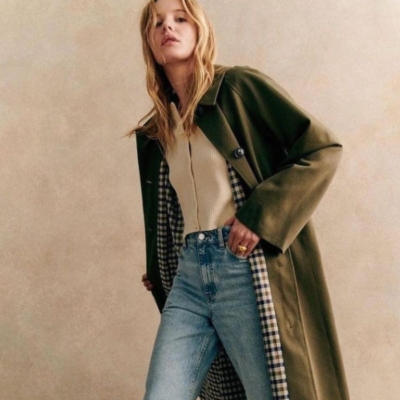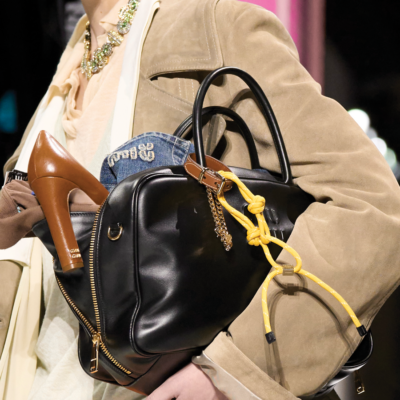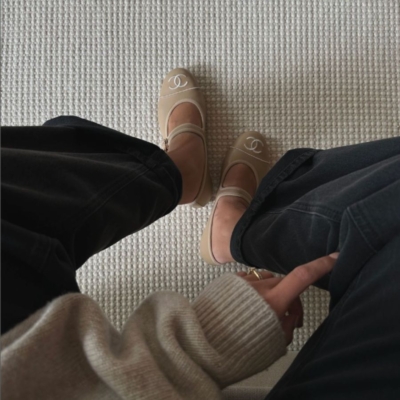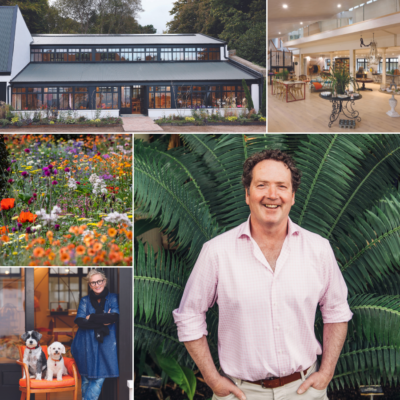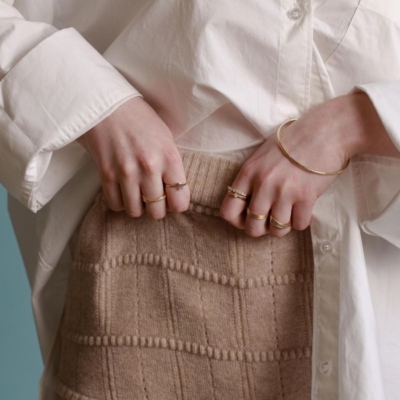Look out! Your online shopping scroll or dip into Zara just got a lot more expensive as inflated prices and hidden costs cause a spike in prices. Sarah Macken navigates the new lifestyle creep and finds ways to bounce back …
Mules or mortgage? As interest rates soar, and inflation skyrockets, your luxury investment might be downgraded to something more modest. On the flip side, your usual payday pick-me-up could end up costing you hundreds. This increasingly familiar phenomenon poses a prickly question: “Why can I no longer afford my own life?”
First things first: it’s not just you, everything is more expensive these days. And, in spite of headlines about inflationary creep, we’re often guilty of disconnecting from what this really means in day-to-day life. A litre of milk? Inching up. A pair of this season’s leather biker boots? They’ll certainly have you feeling the pinch. Consider this word to the wise: economic policy affects how you dress. It affects it a lot, actually.
What’s causing price hikes? Fashion does not operate in a silo – in fact, as one of the world’s most important industries it’s at the epicentre of the current economic turbulence. As the late great Diana Vreeland observed, it’s all connected. “Fashion is part of the daily air and it changes all the time, with all of the events,” she said.
“Energy costs have shot up since the war in the Ukraine. Equally, the low interest rates we’ve experienced since 2008 mean there has been a lot of money sloshing around in the system, plus there’s a tight labour market with the lowest level of unemployment for a decade. Put those together and you’ve got all of the conditions for runaway inflation,” says Mark Coan, founder of Money Sherpa (www.moneysherpa.ie), an advisory firm that specialises in mortgages, investments and pensions.
According to the Consumer Price Index (CPI) the cost of clothes in Ireland increased by just over two per cent in the last twelve months, a rather small jump compared to the swell of housing costs and energy bills (which increased by a hair-raising 20 per cent in the same period), however, considering the cost of clothing was in decline in 2020 and 2021, the result is an upswing of over five per cent. “I’ve noticed a €10 increase across the board in places like COS,” one fashion insider, who haunts the high street, shared recently. She’s spot on. Finding decent staples on the high street – jackets, boots or blazers –under €100 is becoming a rarity. The same pair of straight-leg jeans by Arket, sister brand of H&M, that I buy regularly, has jumped €10 in price since last year. Equally, Chelsea boots from &Other Stories, which used to be in the region of €140, are now creeping towards the €200 mark.
High street shops are moving away from collaborations in the designer sphere and leaning into the appetite for mid-range luxury (think labels with Instagram kudos like Anine Bing and The Frankie Shop) by expanding into premium ranges, with a price-tag to match. Currently, a black leather mouton jacket from Massimo Dutti, which also has a high-end Studio collection, is on sale for €849. There’s investment and now there’s investment high street – a whole new category.
Does a higher price guarantee increased quality? That’s unclear. As competition increases and brands strive to improve their sustainability scores (something we wholeheartedly endorse), it’s hard to know if some hikes are due to more sustainable practices or not. Right now, there’s a question mark over brands who are switching to viscose, often touted as more sustainable than cotton or polyester. The reality is you could pay in the region of €330 for a statement midi-dress for wedding season which is essentially made from a cheap and possibly unethical alternative to silk. (Tip: always check Goodonyou.eco for an unbiased ranking of a brand’s sustainability practices.)
A litre of milk? Inching up. A pair of this season’s leather biker boots? They’ll certainly have you feeling the pinch.
Going shopping? Beware of the hidden creep that shadows you on your next trip. That is, those little add-ons which all add up as brands get creative to recoup costs. Since Brexit, shopping online at independent UK stores means factoring in a chunk for additional customs and taxes. When I bought a jacket recently, I paid nearly half the total price of the item again in import fees. Yes, I know.
Meanwhile, high street giants have upped the amount you need to spend in order to qualify for free delivery, or have abolished it altogether. In Zara’s bricks-and-mortar stores, an environmental fee of 15 cents for paper bags now applies. (We’ll carry a canvas tote instead, thanks.) Rising costs might just put the kibosh on discretionary discounts given out in some stores too. We say it’s no harm to befriend your local boutique owner who might still “knock a bit off ” if you are a regular client.
Interestingly, an economic wobble doesn’t always translate to a shopping freeze. According to a recent survey by Money Sherpa, 13 per cent of Irish people are actually spending more right now. While this may be a rather insulated demographic of high earners, it also reflects the experience of many luxury brands during the last recession: as markets crashed, prices climbed and people paid. To compensate for lower volumes, luxury brands often raise the price of their products as it seems those insulated higher earners are prepared to spend, regardless.
Indeed, since the global pandemic, Chanel has boosted the price of its designer handbags at least four times. According to Sothebys, in 2021, one significant jump saw the price of classic Flap and 2.55 bags increase by 12 per cent in a three-month period alone. Good news for those who like to invest their money where they can see it – in glorious quilted carry-alls. By now, we’re familiar with the idea of buying less, but buying better. But we also crave newness – a proverbial fire in the belly of our wardrobes. The buzzword right now? Adaptability, not austerity. The savvy shopper spends in the right areas of her wardrobe, investing in discerning designers and brands that pack as much punch in terms of polish as they do price point. It’s less about cutting the fat, more about cost-per-wear (the idea that the number of wears you will get out of an item justifies an investment price tag).
As Orla Sheridan (@orlashderidanstyle), a Galway-based personal shopper observes, it’s about knowing where to splash out and where to be savvy. “People aren’t afraid to spend money, but they want to make damn sure they get it right when they do,” she says. Her clients, women in the corporate world, ranging in age from 30 to 50 and above, invest in pieces that are visible every day – a tweed coat by Donegal brand The Landskein or a magnificent knit by Irish designer Colin Burke. They find more glamorous items like going-out dresses on resale sites like Vestiaire Collective. Even those with big budgets are turning to resale platforms to shift older pieces, something Sheridan observes, we wouldn’t have seen ten years ago.
It makes sense that our favourite luxury stores are attuned to the changing mood. While the catwalk at the recent Brown Thomas SS23 presentation served up a riot of sheer fabrics, luminous colour and neominimalism for the new season, behind the scenes buyers are working hard to provide pieces that are both novel and incredibly versatile. According to Shelly Corkery, fashion buying director at Brown Thomas, the likes of Totême – the Stockholm label co-founded by blogger Elin Kling that’s an affordable alternative to The Row and Khaite – is being gobbled up due to “a good price point, beautiful fabrics, great shapes”. Another hot pick is Zimmermann – the Australian brand that excels in feminine, flirty dresses. Dresses are currently the number one category at Brown Thomas, according to Corkery, although there’s less of a fanaticism around florals, more a focus on longer lengths and utility styles.
It makes sense. The drawback of a maximalist dress is that it’s recognisable: so recognisable people will notice when you re-wear it. And, in case you hadn’t noticed, re-wearing your clothes in this climate is not only cool (see the Kates: Middleton and Moss, as well as Meghan Markle), not doing so would be tone deaf. Crunch the numbers: the cost-per-wear of a printed dress you might wear once a fortnight is far higher than a midrange blazer and jeans you may wear up to three times a week. One stylist friend describes how she’s off-loading dresses now, trading them in for statement separates, tailored trousers and drawstring cargos, mixed and matched with a rotation of rounded-shoulder mannish blazers, with T-shirts or blouses layered underneath. Instantly, a multitude of outfits at your fingertips.
Then there’s “recession-core”: the TikTok trend explains how Covid-19 made us obsessed with capsuling and quiet luxury. Rather than waning, two years later, chic staples are the veritable rock stars of our wardrobes (sans the leggings). “I don’t believe in buying a €2,000 dress,” says Sarah Gill, owner of Seagreen (www.seagreen.com), which has boutiques in Ranelagh and Monkstown. “But I would spend money on a Celine blazer,” she says.
Recent price increases have been tough going for boutique owners, says Gill, whose suppliers are tagging on the rising cost of labour and overheads. One area where she has seen a significant jump is denim – jeans that were around €270 are now tipping well over €300. To stay competitive, Gill decided to absorb many of those costs into her own margins, rather than pass them onto the customer. It’s a bold move considering an independent boutique doesn’t have the ability to buy in volume the way big online retailers like Net-a-Porter or My Theresa might. “We might buy ten blazers, they will buy 100 and get them for 20 per cent less, but we both have to sell the blazer at the same price,” she explains.
What about newness? For spring, the boutique has brought back Joseph, the London label that revisits a classic blazer every season. Pair it with a feminine blouse from the boutique’s stable of French brands such as Iro or Ba&sh. Another tip is to look for Second Female – a Scandinavian brand that sits at the lower end of the mid-range scale which delivers on fashionable sweaters, and tops in the region of €120. Perfect for the customer who wants to dip in, without dropping €500. Denim has had an overhaul too, as customers crave a new (non-skinny) silhouette. If you are breaking up with skinnies, try Paige for denim, advises Sarah Gill, its accessible styles are a nice hybrid between skinny and straight. Equally, don’t fear boot-cut jeans. “They’re so flattering and, when paired with a pretty blouse and stacked heels, they look more 1970s cool than 1990s nostalgia,” Gill says.
In times of large-scale global strife, shopping is actually good for you. When there are a large amount of uncontrollable things in your world, it’s key to focus on what you can control. Budgeting for what gives you pleasure is key for your mental health. More so, it’s crucial to splurge on the right things. If you’re a magpie shopper, follow the 30-wear rule (that is, before you buy something ask yourself, “Will I really wear this item 30 times?” If the answer is no, ditch it).
“I never buy anything on the day. I always give myself 48 hours to decide if it’s right for me. Nine times out of ten, I never go back for it,” says Orla Sheridan. Be sustainable and shop your own wardrobe before you go shopping. “Look at what you have and create a list of what you need, plus what suits your lifestyle,” she says. The biggest mistake people make is buying duplicates of the same piece: Sheridan cites one client who had 36 pairs of unworn jeans but was still looking for “the one” perfect pair.
Decorate your own wardrobe by adding embellishments like a floral corsage, popular at Prada, Dries Van Noten and Bottega Veneta this season. Use a shopping service like a virtual shopper (offered now with many Irish retailers via Klarna) to help you buy better and curb the cost of online returns. Enlist a buddy to do an audit of your wardrobe for you, and vice versa. Another person will always see a new way of wearing a piece that you won’t. Although, make sure it’s someone with a penchant for straight-talking honesty. As Sheridan says, “Often, all you need is a fresh eye – and a ruthless friend!”





